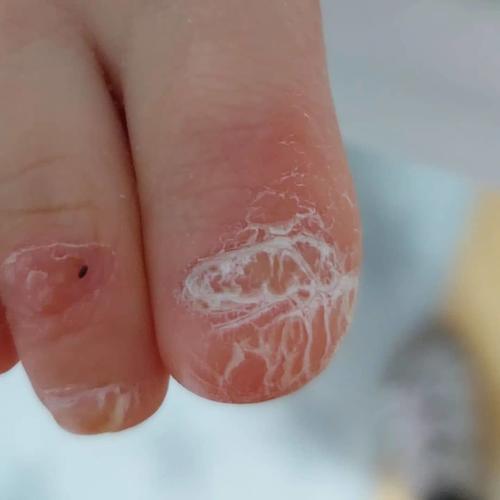Epidermolysis Bullosa: Therapeutic Principles and Treatment
Overview
Epidermolysis bullosa (EB) is a heterogeneous group of inherited mechanobullous diseases. Three basic forms are recognized, based on the electron microscopic level of the blister formation. The ideal strategy would be to correct the genetic abnormality; however, since this is not yet possible, the strategy is to avoid cutaneous trauma if possible and to heal the wounds that result from injury to the skin. Patients with these diseases are best treated in a tertiary care setting. For this reason, the basic principles in the management of all cases of EB will be described in detail, while limited specific therapy for each group is described in the appropriate section.
Basic Therapeutic Principles
- Establishing the diagnosis: There is clinical overlap, so virtually all cases require electron microscopy or immunofluorescent mapping for correct diagnosis. This is critical for therapy, genetic counseling, and prognosis.
- Genetic counseling: Since these diseases are inherited, genetic counseling is essential. Prenatal diagnosis via DNA testing is available for patients in whom previous pregnancies resulted in severely affected children.
- Family education: Some forms of EB are devastating, and demand a significant commitment on the part of the patient, the family, and health care providers. The Dystrophic Epidermolysis Bullosa Research Association of America has been a pioneer patient support and education group. Every family with severely affected children should be advised to contact this group for support and continual education.
- Trauma: Even very minor trauma induces lesions. Efforts to reduce trauma by protection and lubrication are essential to care. Nurse specialists at special EB centers are valuable in training nurses caring for EB patients, and are also key in training the family in the transition of the neonate to home care.
- Infection: Healing is diminished by secondary infection of skin lesions, usually by S. aureus or beta-hemolytic streptococci. Topical antibacterial ointments, specifically mupirocin, can be of great help, but treatment should be limited to short courses, as resistance can emerge. When obvious infection occurs, administer an oral semisynthetic penicillin (dicloxacillin) or a first-generation cephalosporin. Perform cultures, as antibiotic resistance may occur.
- Blister care: The normal skin forming the roof of the blister should be left on as long as possible; it is the optimal biologic dressing. If the hydrostatic pressure of the fluid in the blister tends to increase its size, open the blister and drain the fluid. If a blister becomes infected, drain it and remove the roof. For open erosions, cleanse gently with saline and cover with petrolatum impregnated soft fine-mesh gauze, or alternatively, a soft silicone wound care dressing, the later left on for 7 days.
Dystrophic Epidermolysis Bullosa - Dominant and Recessive Dystrophic Epidermolysis Bullosa
Numerous forms of dystrophic EB occur. Patients having dominantly inherited forms tend to do better, and, although scarring occurs, this subgroup does fairly well and may improve considerably with age. The generalized recessive dystrophic type (RDEB) is often a devastating progressive disease with severe morbidity.
Special Steps
- The management of RDEB requires a team approach. In addition to skin care, nutritional support, physical therapy, psychological support, and good dental care are all essential. Patients should be referred to specialists in each of these fields for regular visits. Ocular, GI tract, GU tract, and respiratory tract complications often occur, usually as a result of scarring. Specialists may need to be consulted.
- Malnutrition, constipation, and anemia are common. Caloric needs are increased by constant skin and blood loss. Transfusion may be required. Vitamin and mineral supplementation is often necessary. High-fiber diet is required. Dietary consultation is essential in severe cases.
- Any nonhealing ulcer or lesion appearing at the edge of a nonhealing ulcer should be carefully evaluated for the possibility of squamous cell carcinoma.
- Repeated surgical procedures may be required to release mitten hands and keep digits functional. Regular endoscopic esophageal dilation may be required.
- Regular immunizations should be given.
Epidermolysis Bullosa, Junctional
All forms of junctional epidermolysis bullosa (JEB) are autosomally recessively inherited. Involvement may be mild (generalized atrophic, localized, and inverse types) or severe (Herlitz and gravis types). Systemic involvement may occur. Pyloric atresia is uniquely associated with JEB.
Special Steps
- Children with JEB have hypoplastic dental enamel and resultant premature caries of both deciduous and permanent teeth. A skilled pediatric dentist must be a part of the health care team
- Bladder and ureteral involvement may rarely occur in JEB, especially in the variant associated with pyloricatresia, leading to hydronephrosis.
Epidermolysis Bullosa Simplex
Multiple subtypes of epidermolysis bullosa simplex (EB simplex) are recognized. All forms are inherited in autosomal dominant fashion. This disease may be generalized and severe (EB herpetiformis of Dowling-Meara), generalized and mild to moderate (Koebner type), or localized to the acral areas (Weber-Cockayne type). Scarring in general does not occur except when lesions become secondarily infected. Because life-threatening complications, scarring, and mucosal involvement are minimal or absent, supportive basic therapy as outlined above is usually adequate. Heat and humidity lower the blistering threshold in EB simplex, so these environmental conditions are best avoided. Well ventilated soft-lined shoes with absorbent cotton socks are recommended. Blistering tends to improve over time, allowing most patients to manage their own conditions effectively with appropriate education and support.
Reference
Berger G, Elias PM, Wintroub BU. Manual of Therapy for Skin Diseases. New York: Churchill Livingstone, 1990

